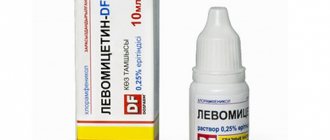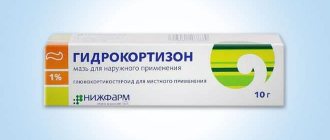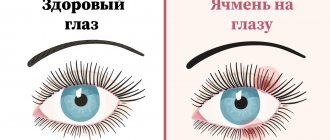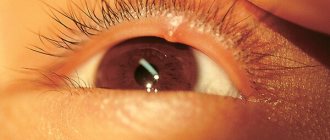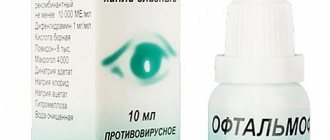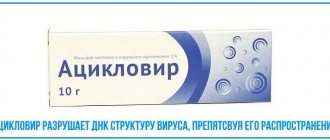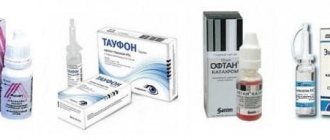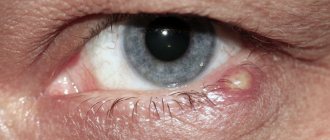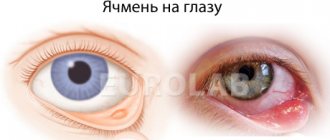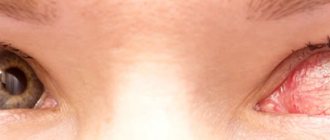Barley (hordeolum) is an infectious inflammation that develops in the sebaceous gland of Zeiss or at the base of the eyelash (hair follicle). Its appearance brings great discomfort, as stye on the eye looks very unattractive and is accompanied by severe pain with any movement of the eyelid.
There is also a variant of internal purulent inflammation - it is formed in the meibomian gland and is visible when the eyelid is pulled back from the inside.
Such a relapse is less common, but as a complication it can lead to a chronic disease of the lower eyelid - chalazion, another name for which is frozen barley.
In this case, most often it is necessary to resort to surgical intervention.
In general, hordeolum is characterized by an unexpected onset and rapid development of inflammation, most often occurring singly.
You cannot treat it as a temporary inconvenience: its occurrence is a clear signal from the body that the immune system is weakened and immediate treatment is required.
Causes and symptoms.
In most cases, the source of barley is the opportunistic microbe Staphylococcus aureus, which is constantly present in the human body, being part of the microflora of the skin and hair.
Its active reproduction can be provoked by simple lack of hygiene.
With a weakened immune system, it will be enough to scratch your eye with a dirty hand or wipe your face with a stale towel and cause an infection.
The following factors also contribute to inflammation:
- Hypothermia (followed by a temporary decrease in immunity);
- The presence in the body of a purulent parasite Staphylococcus aureus;
- Chronic infections - tonsillitis, caries, adenoiditis and others;
- The presence of diseases such as diabetes, seborrhea, chronic blepharitis, anemia, hepatitis;
- Gastrointestinal diseases with disturbances of intestinal microflora;
- Avitaminosis and hypovitaminosis (lack of one or more vitamins);
- Worm infestation;
- Congenital and acquired immunodeficiencies;
- In rare cases - demodex eyelash mite;
Wearing contact lenses or using low-quality cosmetics can also become a factor provoking the disease, but is never the root cause of the disease.
The main symptoms of hordeolum
When independently diagnosing stye on the eye, some photos from the Internet can be misleading, so look above, if you do not have similar inflammatory processes, perhaps you have something else.
You need to know all the symptoms of this disease:
- Burning and itching of the eyelid;
- Sensation of a foreign body under the eyelid;
- Bloating and redness of the eyelid, its hardening;
- Painful sensations from touching the inflamed area and when blinking;
- The appearance of tearing;
- The appearance of a yellow dot on the swelling - an accumulation of pus;
Medicines, antibiotics, tablets and preparations for styes on the eye
The appearance of an abscess on the eyelid (styre) is quite common. Such a purulent formation can appear in both a child and an adult. This raises many questions: how to treat the disease, what medicine to use for stye on the eye. Let's figure it out.
Features of pathology and choice of treatment method
Barley is an inflammation in the eye area that develops as a result of the aggressive action of a bacterial (less commonly viral or fungal) infection. It is characterized by acute development and the presence of a purulent process.
Most often, the development of barley is provoked by a staphylococcal infection (in 90% of cases). These pathogenic bacteria can remain in the body for a long time without manifesting themselves. But in the presence of certain factors, they are activated and multiply, manifesting themselves in the form of an abscess on the eye. This is facilitated by a decrease in human immunity, which occurs due to many reasons:
- prolonged hypothermia;
- mental or physical overload;
- constant stress;
- infectious diseases (including sexually transmitted diseases);
- colds;
- pathologies of the gastrointestinal tract;
- vitamin deficiency (lack of vitamins);
- metabolic disorders (for example, diabetes).
Also, the development of barley is influenced by external factors that contribute to the penetration of infection and the development of the inflammatory process. Among them:
- Failure to comply with personal hygiene rules. For example, people often touch their eyes with dirty hands, use other people's cosmetics or personal belongings.
- Contact with dust or small foreign bodies in the eyes.
- Penetration of mites that live on eyelashes (Demodex).
- Contact with various allergens in the eyes.
The appearance of styes is also associated with hormonal imbalances in adolescents (during puberty), in women during pregnancy, breastfeeding, and also during menopause.
When barley appears on the eye, the patient needs to quickly cure it in order to prevent a number of unpleasant consequences from occurring. Among them are:
- chronic form of the disease (when abscesses appear systematically);
- phlegmon of the orbit (diffuse purulent inflammation);
- sepsis (spread of infection);
- meningitis (inflammation of the structures of the brain and spinal cord).
In order not to provoke the appearance of such dangerous complications, treatment of barley must be started as early as possible. If this is not done, you can provoke a significant deterioration in vision.
There are several methods for treating stye on the eye. The following are distinguished:
- Drug therapy. It involves the use of medications in various forms. These can be external agents (drops, ointments) or drugs that need to be taken orally (tablets, injection solutions).
- Hardware treatment. For this purpose, various types of procedures are used that promote the resorption of the abscess and its speedy healing. For this purpose, helium-neon laser, UHF therapy, warming compresses, massage and other manipulations are used.
- Traditional methods of treatment. Such therapy can only help with mild forms of the disease. In case of complications, it is better to seek qualified help from an experienced ophthalmologist.
- Surgical intervention. It is indicated when there is no effect when using the above methods.
Principles of medicinal effects
At the moment, the most effective way to quickly get rid of an abscess on the eye is medication. In this case, treatment of barley with the help of pharmaceutical products is aimed at:
- relieving the inflammatory process;
- eliminating the cause of the abscess;
- combating the pathogen (most often bacterial flora);
- disinfection of the affected area;
- relieving associated symptoms (for example, pain);
- increasing the immune properties of the body.
Several groups of drugs are used for this. Such medicines for barley are:
- Anti-inflammatory drugs. They help get rid of the inflammatory process. They are used topically (in the form of external ointments or drops) or internally. Echinacea and propolis tinctures are often used.
- Antibacterial drugs. Most often, the appearance of an abscess in the eyes is provoked by a bacterial infection (staphylococcus, less often streptococcus). Antibiotics can quickly resolve this problem. All these drugs must be prescribed by the attending physician and used under his supervision. Since the group of antibacterial agents has a number of contraindications. The following antibiotics are prescribed for barley:
- drops (Tobrex, Albucid, Gentamicin, Levomycetin);
- tablets for oral administration (Amoxil, Ofloxacin).
ointments (Tetracycline, Erythromycin);
- immunomodulators (Immunal);
vitamin complexes (Supradin);
If barley occurs, it is necessary to begin proper treatment on time. In the absence of such an impact, negative consequences may occur, as well as the development of an acute form of the disease into a chronic one. Before treating stye on the eye, you should understand the reasons for its appearance and eliminate them.
The most effective drugs
To quickly get rid of stye, you need to seek help from an ophthalmologist. He will help you find out why the abscess appeared on your eye and prescribe the appropriate treatment. Most often, one medicine used for stye on the eye does not give a positive result. Therefore, the doctor prescribes complex therapy.
First of all, local treatment is needed. In this case, agents that have antiseptic properties are used. For example, brilliant green (brilliant green) has such properties. This is a 1% alcohol solution, which is used for external treatment of wounds for the purpose of disinfection. Fukortsin is used for the same purpose.
External agents are used to treat abscesses. To do this, use ointments to treat the abscess, as well as drops to eliminate the infection and relieve the inflammatory process. Among the effective ointments are:
- Tetracycline. It contains a broad-spectrum antibiotic, tetracycline.
It has bacteriostatic properties, affecting pathogenic microorganisms (including staphylococcus, streptococcus, E. coli and others).
The ointment is indicated for the treatment of inflammatory processes of the eyes, which are caused by the aggressive action of microbes sensitive to tetracycline. The drug has a number of contraindications. Ointment is not used:
- for the treatment of young children (up to 6 years);
- not used for viral or fungal infections;
- for the treatment of pregnant and lactating women. When using the ointment, the following side effects may occur:
- increased sensitivity to sunlight;
- allergic reaction.
in case of individual intolerance to components;
problems with the gastrointestinal tract;
It acts bacteriostatically on certain types of bacteria (staphylococci, streptococci, ureaplasma, gonorrhea, mycoplasma and others). Well tolerated compared to penicillins. Contraindications are individual intolerance, as well as severe liver disease. Side effects include:
- local irritation in the form of rash, redness, itching;
allergic reactions.
With prolonged use of erythromycin ointment, a secondary infection may occur, caused by bacteria resistant to the current antibiotic. The method of application and duration of treatment are the same for both products. Ointments are usually placed behind the lower eyelid in a small amount 3 times a day. The course of treatment is determined by the doctor, it should not exceed 2 weeks.
Eye drops containing antibiotics are also effective. They are dripped into the conjunctival sac 2-3 times a day for 10-14 days. Afterwards, the course of treatment should be temporarily stopped. Among such means are:
- Levomycetin.
- Tobrex.
- Gentamicin.
What not to do with barley
If you have swelling on your eyelid, under no circumstances should you do the following:
- comb the sore area with your hands;
- use contact lenses during illness;
- use any cosmetics, even high-quality ones;
- try to hide the swelling with a band-aid;
- warm up after the appearance of pus;
- try to squeeze out or open the purulent head with a sharp object;
- apply wet compresses to the eyes;
- in the cold season, before going outside, it is necessary to apply a dry sterile bandage to the sore eye;
- overheat barley, go to the bathhouse, sauna or hot shower.
Having seen a photo of stye on the eye on the Internet, you can get scared and even listen to folk signs like spitting in the eye and washing it with urine. This cannot be done, such actions can only lead to additional infection in the eye, and not to recovery!
Causes
As already mentioned, in most cases, barley appears due to bacterial infection. If the meibomian gland, located behind the inner row of eyelashes, becomes infected, internal stye occurs - the most unpleasant type of pathology.
Both external and internal barley can appear under the influence of a number of favorable factors:
- Reduced level of immunity;
- Hypothermia;
- Hypovitaminosis;
- Past infectious diseases;
- Chronic pathological processes in the digestive organs;
- Metabolic disorders (furunculosis, diabetes);
- Chronic inflammation of the eyelids (blepharitis, demodicosis).
Sometimes the process begins with infection with a skin mite (demodex), the waste products of which have a strong irritating and inflammatory effect. As a result, favorable conditions arise for bacterial infection.
How to quickly cure stye
The initial stage of the disease still allows you to quickly prevent relapse.
If you take action immediately after the appearance of the primary symptoms - itching, redness and pain - the infection may not have time to spread and suppuration will not appear, the swelling will disappear without a trace within 1-2 days.
- First of all, it is necessary to treat the affected area with an antiseptic. Regular vodka or medical alcohol is suitable for this. You need to dilute it with water in a 1:1 ratio, soak a cotton swab in alcohol, squeeze it hard and apply it to the inflamed area, at the very base of the diseased eyelash. Avoid getting medication in your eyes! If you don't have vodka on hand, use brilliant green or iodine containing alcohol. This method avoids the development of an abscess.
- A good remedy at the very beginning of the development of infection is dry heating. To do this, you can hard-boil an egg, or heat sea salt or any cereal in a frying pan - buckwheat, wheat, rice. Next, the resulting heat source should be wrapped in a clean cloth (you can use a handkerchief) and kept on the eye until the dry compress cools down. This will speed up the “ripening”, but do not overdo it: pus can come out in the opposite direction, under the eyelid, get into the conjunctiva and cause sepsis.
Treating barley with medication
If it was not possible to prevent the development of inflammation, the best solution would be to consult a doctor for an accurate diagnosis and drawing up the correct drug treatment program.
Rules of application
The main rule when treating barley is to follow all the doctor’s recommendations and the instructions included with the medications. If treatment is carried out at home, then you must follow a few simple rules:
- Be sure to wash your hands with soap and water before using the medicine;
- Store medications in accordance with the conditions required in the instructions and out of the reach of children;
- Be sure to include natural vitamins in your diet - they will maintain the immune system at the proper level and ensure rapid tissue restoration;
- If there is a threat of relapse, the use of UHF and quartz treatment is effective - consult your doctor about the advisability of the procedures;
- Use folk remedies only after consultation with an ophthalmologist.
Eye drops for redness and irritation
Eye drops for allergies with names are described in this article.
Diclofenac eye drops with instructions https://eyesdocs.ru/medicinaoperacii/lekarstva/kapli-diklofenak-opisanie-preparata-i-pravila-priema.html
Treatment of barley in children
If a child complains of pain and itching in the eye, this most often indicates the appearance of hordeolum. Unfortunately, many parents begin to read incorrect articles about stye on the eye, looking at images that can frighten the child’s parents and provoke thoughtless self-medication, even folk conspiracies.
If barley appears in a child, and within 3-4 days it was not possible to stop the development of the tumor using the described means, you should definitely contact a pediatrician.
In the case of a child under 1 year old, you need to go to the doctor immediately - you cannot prescribe treatment for the baby yourself, so as not to provoke an allergic reaction.
Ointments
Inflammation of the sebaceous gland is more effectively treated with ointments, since they act directly at the site of infection. Ophthalmologists recommend the following medications:
- “Tetracycline ointment” is an inexpensive and effective remedy, the price is about 50 rubles;
- “Erythromycin ointment” - if the disease is caused by rare types of bacteria, costs 60 rubles;
- “Oftocipro” is an antibiotic active against many bacteria, price 180 rubles.
The ointment is applied to the skin every 4-6 hours. The duration of treatment depends on the size of the barley, 7-14 days. Ointment forms are applied after instilling drops. Absorption of the medicine occurs within half an hour.
Find even more ointments with descriptions for barley here.
Prevention of stye
By following a few basic rules of hygiene and a healthy lifestyle every day, you can avoid not only stye, but also many other, more dangerous diseases.
- Maintaining immunity. Since the main cause of barley disease remains reduced immunity, it is worth adjusting your diet and diversifying your diet with vegetables and taking a course of adaptogens (tinctures of radiola rosea, Schisandra chinensis, Eleutherococcus or ginseng). You should also avoid possible stress as much as possible, get enough sleep and incorporate physical exercise into your daily schedule. Even standard morning exercise for 10-15 minutes significantly improves overall well-being and keeps the body in good shape.
- Hand hygiene is mandatory. It is also necessary to get rid of the habit of unconsciously touching your eyes during the day.
- In the morning and evening, while washing your face, clean your eyes with cotton pads or a sterile bandage. You can use moisturizing eye drops throughout the day. If you use contact lenses, follow all rules for wearing and caring for them.
- Each family member should have their own towel and cosmetics.
- Preventive procedures in areas where hordeolum appears.
In itself, this swelling on the eyelid does not pose a great threat to the body if you do not let its development take its course and seek help from specialists before complications arise.
Other types of eye drops
Symptomatic and preventive medications are medications that quickly help improve well-being and prevent complications of stye: conjunctivitis, keratitis, etc. Such medications are used as an addition to the main therapy, but in no case instead of it.
Among the symptomatic remedies, “Balarpan”, “Vizin”, “Artificial tear” have proven themselves well. These drugs relieve fatigue and irritation of the eyes, moisturize them.
The latter is very important, because Large styes often prevent the eyelid from closing completely, causing the cornea to constantly dry out. The only, but very significant, unpleasant feature of symptomatic remedies is that they can mask signs of complications, so when using them you need to be careful about your condition.
Also, for better treatment, doctors in some cases prescribe a number of other drugs:
- antiallergic - to enhance the effect of anti-inflammatory drops;
- antiviral - to prevent viral complications (for example, with barley against the background of a cold or flu);
- restorative - to accelerate the healing of the eyelid and cornea.
To make the patient comfortable, instead of a large number of medications, combined action drops are prescribed, combining several active ingredients. If several types of drops are recommended, the patient should observe an interval of 15-20 minutes between their administration. The doctor will explain in what order to instill the drops. If drops and eye ointment are prescribed, then the drops are administered first.
Antibiotics drops
Eye drops containing antibiotics are considered effective local remedies. The liquid enters directly onto the conjunctiva and is quickly absorbed and absorbed.
Most often, experts prescribe the following drops:
- "Levomycetin". It has a bacteriostatic effect, destroys bacteroids, staphylococci, streptococci. It enters the systemic circulation in limited quantities and is excreted from the body due to the work of the kidneys. The drug should be used several times a day, 1 drop is instilled into each eye. You need to make sure that the liquid gets into the conjunctival sac,
- "Tsiprolet". The main active ingredient is ciprofloxacin, which causes the death of pathogenic microorganisms. Should be used with caution in cases of seizure activity and atherosclerosis in an adult,
- “Albucid” is a common drug that works due to sodium sulfacetamide. Fights pathogenic cocci, penetrates into the systemic bloodstream in small quantities through the conjunctiva.
Drops for barley are used strictly on an hourly basis, following the dosage prescribed by the doctor.
